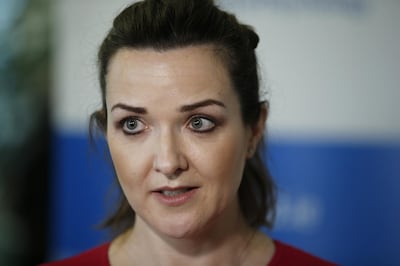Eileen Keane Haly still remembers how nervous she was about letting the eldest of her four daughters, Megan, out to her first disco. But when her youngest child Erin was running out the door to enjoy that same milestone, there was no parenting issue at all.
“By that time I had realised that all of these new freedoms are part of growing up, and we do need to trust our kids here, at least until they give us a reason not to.”
Trust. Letting go. Boundaries. Freedom. They’re all elements of an intricate balancing act when there’s a tween or teen in the house.
"In my experience the child who knows he is trusted is so much slower to break that trust," writes Keane Haly, a Cork-based life and parent coach in her new book, The Parent: how to Navigate the Ever Changing World of Parenting."
Just how important it is for children’s wellbeing that parents “let go” and give them a sense of autonomy is highlighted in the latest report from the surveying of nine-year-olds and 13-year-olds in Growing Up in Ireland, the national longitudinal study of our children.
Growing Up in Ireland: Social-Emotional and Behavioural Outcomes in Early Adolescence by Dr Elizabeth Nixon, assistant professor in psychology, Trinity College Dublin, shows a clear link between lower levels of depressed mood among adolescents and higher levels of autonomy granted by their parents. A sense of autonomy is also associated with less anti-social behaviour.

It’s a timely message for parents when micro-management of children’s lives is on the rise, as is reported poorer wellbeing among adolescents. These findings suggest the two are connected, and come as no surprise to psychotherapist Stella O’Malley, who has written several books relating to this topic, starting with Cotton Wool Kids.
“Not only do I feel it is instinctively true,” she says, but this latest Irish research backs up the conclusions of other studies she has read.
“It is incredibly important and it is overlooked these days. We have replaced autonomy with safety. As a result, we have ‘saved’ our children but they are as not as happy and that is a very dangerous exchange we’ve made.”
Separation
So, what is meant by “autonomy”, and how can parents balance it with the boundaries that adolescents also need?
There are two facets of autonomy, explains Nixon, the first being separation, both the physical separating, when adolescents are spending more time away from home and without adult supervision, and the start of emotionally separating from parents.
The second facet of autonomy is, in psychology speak, “individuation”, which is where the adolescent is trying to take on more responsibility for themselves and become less dependent on their parents. They are moving away from the family unit and more towards the peer group.
The granting of autonomy by both mothers and fathers is linked in the study to girls having lower depressive mood, whereas for boys it is just the mothers’ autonomy granting that is associated with lower levels of internalising difficulties.
When looking at the adolescents’ externalising difficulties, such as anti-social behaviour, says Nixon, the links to autonomy giving that become apparent are between mothers and daughters and fathers and sons.
“The context for all this is the pre-existing relationship between the parent and the child,” she says. “It is an evolution of that relationship. I think it is something that parents often struggle with because in some way they feel they are losing their child.”
There is a sense that a once cuddly affectionate child is slipping away; the one that used to come home from school dying to tell you everything is no longer chatty.
“Parents might feel ‘they don’t talk to me anymore; I have no idea what is going on in their lives’. There is a change and I think parents can sometimes experience that as a loss,” says Nixon. “Whereas it is a normal thing, and a sign of positive development. What we want parents to do at this stage of their child’s development is support their child’s autonomy.”
Mental health
This is likely to have a positive impact on both the parent-child relationship and the youngster’s mental health. “As humans we all have a desire to be self-determining and have an element of control over our lives. That is what adolescents are striving towards.”
She is often amazed how little even very well educated parents seem to know about child development. Understanding it a bit more would help parents be kinder to themselves, she suggests. They might be less likely to fret about where they, and/or their children, are going wrong.
There is a lot of conflict in adolescent-parent relationships because adolescents “begin to question the legitimacy of the hold parents have over them”. They start to fight back against things that are always the way they were.
Parents may feel they spend all their time giving out but what lies at the heart of the adolescent’s questioning is the start of the individuation process.
This is “normal, positive and good”, she stresses. “Parents don’t want children who are going to be conformists throughout their lives but where else are they going to learn to question things if it is not within the security of the home environment?”
Judging just how much free rein to give can be a hard balance, she acknowledges. But you can give a child quite a lot of psychological autonomy yet still have quite strict rules if you involve the child in making those rules.
Some things just aren’t open to negotiation, on safety grounds, and she believes adolescents accept that when it is explained. However, they are less likely to see why parents should control things such as what time they have their meals at, what they eat, their choice of clothing, how they organise the private space of their bedroom, who their friends are, where they hang out with their peers, etc.
Nixon encourages parents to look for ways to provide adolescents freedom in a safe way. While a lot of attention is paid to separation, she thinks there is less emphasis on individuation. “So what if they want to dye their hair red in the summer holidays?”

Capability
Keane Haly believes strongly in involving children in running the household by giving them chores even when it would be easier for parents to do things themselves. Contributing in this way gives children a sense of pride and capability, she says, which builds their confidence in taking responsibility for themselves.
The study observes that it is possible that young people who behave more responsibly are granted more autonomy from their parents; on the other hand, when parents grant their children autonomy they may behave more responsibly.
Even my own teenager has commented that among his peers those inclined to wilder behaviour have the strictest parents. So, do the parents need to be stricter because of these teens’ behaviour or are the teens reacting to the parents’ attempts to control them?
Stricter parents would say their restrictions are necessary for their children, says O’Malley, but she’s not convinced.
“I have seen kids who have been told since the age of three ‘don’t, don’t, don’t…. down, down, down’.” As a result they don’t weigh up safety because their parent is always fretting about it, “so they are like a greyhound out of a trap every time because somebody else is looking after the safety”, she says.
Keane Haly admits “I was that teenager” who rebelled extensively against parental authority and, “with no judgment on my parents”, trust was lost between her and them for a time. In such situations parents are much more likely to try to clamp down further than loosen the leash, which might be more effective.
She believes parents are the best judge of how much they can trust their own children, and should not be swayed by the advice of other parents or family members who maintain “she is too young for a phone” or “they never tell the truth at this age”. But holding boundaries is essential too.
“If they are clear on what you expect of them and they know you trust them, you are definitely on the right track,” says Keane Haly. And if a child does break your trust, “they need to know that this is a really big deal, there needs to be repercussions”. It is always easier to let them off, but in that case the lesson will not be learnt, she says .
Harder work
O’Malley agrees that judicious autonomy granting is harder work for parents.
“You have to give them freedom and you have to give them boundaries, and it is much easier on the [parent’s] brain just to give them boundaries. It is hard to give them both.”
Although boundaries constrain freedom, involving teens in negotiation of those boundaries helps to give them a sense of autonomy. “For some parents the idea of negotiating with their children could be quite foreign; others may have done it all along,” says Nixon, who stresses that it is the adolescent’s perception of having autonomy that is crucial.
It is about the sense rather than the reality, because autonomy will look different in different contexts. For example, children living in rural areas can’t be as autonomous in getting out and about because they need lifts everywhere. “They do need to have a voice and that is tiresome,” O’Malley agrees wryly, as the mother of two children aged 11 and 13. There must also be genuine listening.
“It is very satisfying for the parent to have very obedient and compliant children but they don’t fare well in life.” They tend to have high self-loathing and low self-esteem.
In psychological terms it’s all about “locus of control”, she says. If you have an internal locus of control, you have a sense of autonomy, you feel in charge of the world. When we over-restrain children we give them an external locus of control, whereby they presume other people – parents, teachers, God – determine their happiness and they don’t self-motivate to make themselves happy.
“If they are being hovered over as early as the playground we are giving them the message inadvertently that their happiness lies in the hands of their parents.”
If we can back off “we will give them the chance to be master of their own ship”, she says. “It is our job to bring them to the playground, it is their job to be happy in the playground.”
More risks
O’Malley adds that there is research which shows that the more physical restrictions you put on a teenager, the more risks they will take on line. That underlines the fallacy of believing that a teen is safer when at home, on their devices, rather than hanging out with friends.
“The teenage natural disposition is towards risk and adventure and challenge. They need to have some. What you win on the roundabouts you’ll lose on the corners and that’s something to be careful of.”
Nixon hopes her study’s findings will prompt parents to take a step back and consider what impact their controls on various aspects of an adolescent’s life means to the young person. In many cases “these things matter a lot more to the young person than they do to the parent”.
Read: The controlling parent is having a good Covid









